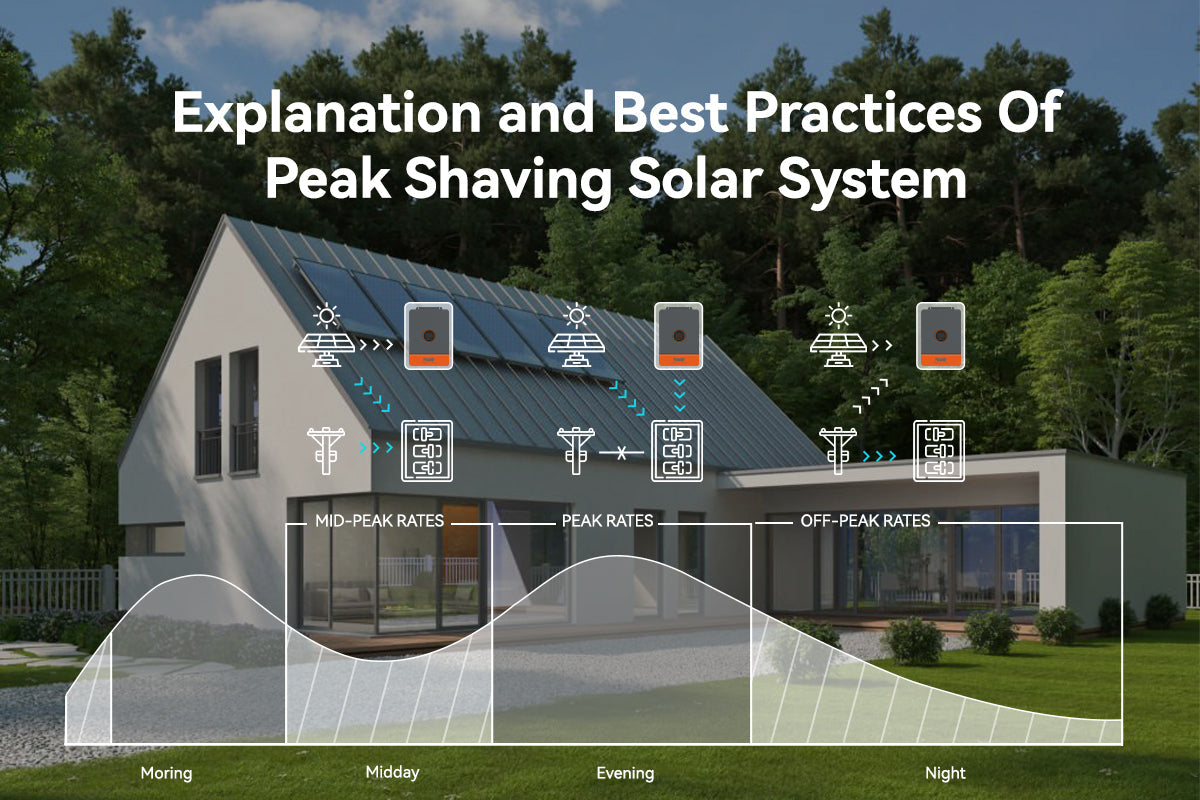เพื่อ สร้างสมดุลระหว่างการจัดหาพลังงานและความต้องการและบรรเทาความกดดันของกริด บริษัทสาธารณูปโภคจึงมีการนำเสนอโครงสร้างอัตราค่าบริการที่สร้างสรรค์อย่างต่อเนื่องเพื่อตอบสนองความต้องการของผู้บริโภคพลังงานในที่อยู่อาศัย เป้าหมายร่วมของความพยายามเหล่านี้คือการกระตุ้นการใช้พลังงานเมื่อค่าใช้จ่ายในการผลิตต่ำและลดการใช้พลังงานเมื่อค่าใช้จ่ายสูง.
การตั้งราคาแบบตามเวลาใช้งาน หรือที่เรียกว่า อัตราค่าบริการตามเวลาใช้งาน เป็นระบบอัตราค่าบริการที่ใช้กันอย่างแพร่หลาย ตามที่ หน่วยงานสหภาพยุโรปเพื่อความร่วมมือของผู้ควบคุมพลังงาน ระบุว่า 21 ประเทศในยุโรป (หรือ 75%) นำ อัตราค่าบริการตามเวลาใช้งานมาใช้ ในขณะที่ 7 ประเทศ (BG, CY, DE, HU, IT, LU, RO) ไม่ได้นำมาใช้.

การตั้งราคาแบบตามเวลาใช้งานทำงานโดย เปลี่ยนแปลง อัตราค่าไฟฟ้า ตลอดทั้งวัน โดยมีอัตราที่ต่ำกว่าในช่วงเวลาที่ไม่ใช่ชั่วโมงเร่งด่วนและอัตราที่สูงกว่าในช่วงชั่วโมงเร่งด่วน ซึ่งกระตุ้นให้ผู้บริโภค เปลี่ยนการใช้พลังงานไปยังช่วงเวลาที่ไม่ใช่ชั่วโมงเร่งด่วน เพื่อลดความต้องการในช่วงพีคและความเครียดของกริด ซึ่งเป็นแนวคิดที่เรียกว่า "การตัดยอดพีค".
ในบล็อกโพสต์นี้ เราจะเจาะลึกถึง ความสำคัญ ของการลดพีคในระบบพลังงานแสงอาทิตย์ และสำรวจ แนวทางปฏิบัติที่ดีที่สุด เพื่อให้ได้ประโยชน์สูงสุดจากวิธีการที่เป็นนวัตกรรมนี้.
Peak Shaving คืออะไรและมันทำงานอย่างไร
การตัดยอดพีคเป็นกลยุทธ์ที่ใช้ในด้านการจัดการพลังงานแสงอาทิตย์เพื่อเพิ่มการใช้พลังงานที่ผลิตโดยแผงโซลาร์เซลล์ในช่วงเวลาที่เฉพาะเจาะจง.
การลดพีคเกี่ยวข้องกับการ ลด การใช้ไฟฟ้าจากกริด ในช่วงเวลาที่มีความต้องการสูง โดยปกติในช่วงเวลาพีค เพื่อช่วยลดต้นทุนพลังงานและลดความเครียดบนกริดไฟฟ้า ซึ่งมักจะทำได้โดยการลดการทำงานที่ไม่จำเป็นชั่วคราวหรือ เปลี่ยนไปใช้แหล่งพลังงานทางเลือก.
"การเติมเต็มหุบเขา" ถูกใช้ร่วมกับ "การตัดยอด" เพื่อให้เกิดศักยภาพสูงสุดของระบบพลังงานแสงอาทิตย์ มันเกี่ยวข้องกับการ ปรับตำแหน่ง ของ จุดสูงสุดของความต้องการพลังงาน ในกริด ไปยังช่วงเวลาที่มีอัตราค่าไฟฟ้าต่ำ เช่น ช่วงดึก นโยบายนี้ใช้ประโยชน์จากราคาค่าไฟฟ้าที่ต่ำกว่าในช่วงเวลาที่ไม่ใช่ช่วงพีคและเพิ่มประสิทธิภาพการใช้พลังงานส่วนเกินที่อาจจะสูญเปล่าไปได้.

การรวมการตัดยอดสูงสุดและการเติมยอดต่ำสุด ผู้บริโภคสามารถ ปรับระดับ ความต้องการไฟฟ้าของตนให้สม่ำเสมอตลอด 24 ชั่วโมง ซึ่งเป็นประโยชน์ทั้งต่อตนเองและต่อกริด วิธีการนี้ไม่เพียงแต่ช่วยลดต้นทุนพลังงาน แต่ยังช่วยเพิ่ม ความเสถียรของกริด ลดผลกระทบต่อสิ่งแวดล้อม และส่งเสริมความเป็นอิสระด้านพลังงาน.
แนวทางปฏิบัติที่ดีที่สุดในการออกแบบและดำเนินการระบบการลดพีค
หนึ่งในแง่มุมที่สำคัญที่สุดของการลดพีคคือ การรวมระบบจัดเก็บแบตเตอรี่ แบตเตอรี่มีความสำคัญในการเก็บพลังงานส่วนเกินที่ผลิตขึ้นในช่วงเวลาที่ไม่ใช่พีคเพื่อนำมาใช้ในช่วงเวลาที่มีความต้องการสูง พวกเขา ทำหน้าที่เป็นบัฟเฟอร์ ช่วยให้คุณสามารถปรับเปลี่ยนการใช้พลังงานและลดการพึ่งพาเครือข่ายไฟฟ้าเมื่อค่าไฟฟ้าสูงขึ้น.
เพื่อดำเนินการกลยุทธ์การลดพีคที่มีประสิทธิภาพภายในระบบพลังงานแสงอาทิตย์ ควรนำแนวทางปฏิบัติที่ดีที่สุด ต่อไปนี้:
ประเมินโปรไฟล์การใช้พลังงานและอัตราค่าไฟฟ้าตามเวลา
การบรรลุการลดพีคต้องพิจารณาอย่างรอบคอบในสองปัจจัยที่สำคัญ: โปรไฟล์โหลด และ ตารางอัตราค่าไฟฟ้า.
โหลดโปรไฟล์
เริ่มต้น จำเป็นต้องทำการวิเคราะห์อย่างละเอียดเกี่ยวกับ กราฟการใช้ไฟฟ้า การวิเคราะห์นี้จะช่วยให้คุณเข้าใจว่าการใช้พลังงานมีการเปลี่ยนแปลงอย่างไรในช่วงเวลาต่าง ๆ ของวัน.
โดยการตรวจสอบข้อมูลนี้ คุณสามารถระบุ เมื่อโหลดสูงสุดเกิดขึ้น และกำหนด ปริมาณพลังงานที่ต้องการ ในช่วงเวลาที่มีการโหลดสูงสุดเหล่านี้ได้อย่างแม่นยำ.
ตารางอัตราค่าไฟฟ้า
นอกจากนี้ สิ่งสำคัญคือต้องมีความเข้าใจที่ชัดเจนเกี่ยวกับ โครงสร้างอัตราค่าไฟฟ้าตามเวลาใช้งาน (TOU) ของบริษัทสาธารณูปโภคของคุณ อัตรา TOU เกี่ยวข้องกับราคาค่าไฟฟ้าที่แตกต่างกันตลอดทั้งวัน โดยทั่วไปจะมีอัตราที่สูงขึ้นในช่วงเวลาที่มีการใช้ไฟฟ้าสูงสุดและอัตราที่ต่ำกว่าในช่วงเวลาที่มีการใช้ไฟฟ้าต่ำ นี่คือความรู้ที่มีค่าในการปรับแต่งกลยุทธ์การจัดการพลังงานของคุณ.

การเข้าใจความแปรผันของอัตรานี้จะช่วยให้คุณสามารถตัดสินใจได้อย่างมีข้อมูลเกี่ยวกับเวลาในการใช้หรือเก็บพลังงาน
ตั้งค่าระบบการตัดยอดพีค
ด้วยความเข้าใจอย่างถ่องแท้เกี่ยวกับโปรไฟล์การโหลดและโครงสร้างอัตรา TOU ของคุณ คุณจึงสามารถตั้งค่าระบบการลดพีคของคุณได้แล้ว
การดำเนินการระบบพลังงานแสงอาทิตย์สามารถปรับให้เหมาะสมกับเป้าหมายและกลุ่มผู้ใช้ที่แตกต่างกันขึ้นอยู่กับความต้องการและความชอบเฉพาะของพวกเขา นี่คือบางสถานการณ์และกลุ่มผู้ใช้ที่อาจมีแนวโน้มไปสู่ "การใช้พลังงานเองโดยไม่มีการส่งออก" หรือ "การใช้พลังงานเองที่เหลือ"
ตัวเลือก 1 - การลดพีคเพื่อการบริโภคเองโดยไม่มีการส่งออก
การลดพีคเพื่อการใช้เองโดยไม่มีการส่งออกเป็นกลยุทธ์ที่มุ่งเน้นการใช้พลังงานที่ผลิตจากโซลาร์ภายในทรัพย์สินของคุณให้มากที่สุดโดยไม่ส่งพลังงานส่วนเกินกลับไปยังกริด เป้าหมายคือการใช้พลังงานที่คุณผลิตได้มากที่สุด โดยเฉพาะในช่วงเวลาที่มีการใช้พลังงานสูง เพื่อลดค่าไฟฟ้าและลดความตึงเครียดของกริด.
หม้อแปลงกระแสไฟฟ้าเป็นส่วนประกอบสำคัญในการตรวจสอบการไหลของพลังงาน โดยการติดตั้ง CTs คุณสามารถวัดการใช้ไฟฟ้าและการผลิตไฟฟ้า ซึ่งช่วยให้ควบคุมการไหลของพลังงานได้อย่างแม่นยำ
PowMr Peak Shaving Inverter ที่มาพร้อมกับ CT สามารถมีบทบาทสำคัญในกลยุทธ์นี้ มันช่วยติดตามการใช้ไฟฟ้าของคุณแบบเรียลไทม์และมั่นใจว่าคุณจะไม่ส่งออกพลังงานส่วนเกินไปยังกริด.
ยกตัวอย่างเช่น รุ่น SunSmart 10K ด้วยฟังก์ชันการตั้งค่าการชาร์จและการปล่อยพลังงานในช่วงเวลาที่กำหนด คุณสามารถตั้งช่วงเวลาสำหรับการตัดการชาร์จจากไฟฟ้าหลักและสลับช่วงเวลาระหว่างการปล่อยพลังงานจากแบตเตอรี่และโหมดจ่ายไฟจากไฟฟ้าหลักได้.
มันมีช่วงการชาร์จที่กำหนดได้สามช่วงและช่วงการปล่อยประจุสามช่วง ซึ่งเหมาะสำหรับการเพิ่มประสิทธิภาพการใช้พลังงานตามอัตราค่าบริการตามเวลาที่ใช้ในแต่ละภูมิภาค.

ด้วยฟีเจอร์นี้ คุณสามารถตั้งค่าระบบโซลาร์เซลล์ที่มีการเก็บพลังงานแบตเตอรี่เพื่อลดการใช้พลังงานในช่วงพีคที่ไม่ส่งกลับไปยังกริดได้:
การลดพีค - กำหนดระยะเวลาการปล่อยประจุของแบตเตอรี่
- ตามตารางเวลาใช้งานในท้องถิ่น ให้ค้นหาช่วงเวลาที่มีการใช้ไฟฟ้าสูงสุดและกำหนดให้เป็น "ช่วงเวลาการปล่อยประจุแบตเตอรี่".
- ในช่วงเวลานี้ หน้าที่หลักของอินเวอร์เตอร์คือการดึงพลังงานจากแบตเตอรี่เพื่อตอบสนองความต้องการโหลด โดยพลังงานจากกริดจะเป็นทางเลือกสุดท้าย.
การเติมวาล์ว - ควบคุมช่วงเวลาการชาร์จพลังงาน
- ตามตารางการใช้ไฟฟ้าตามเวลาท้องถิ่น ให้กำหนดช่วงเวลาที่มีค่าไฟฟ้าต่ำที่สุดและตั้งเป็น "ช่วงเวลาชาร์จไฟฟ้า".
- ในช่วงเวลานี้ อินเวอร์เตอร์จะให้ความสำคัญกับการใช้พลังงานแสงอาทิตย์เพื่อตอบสนองความต้องการโหลดและชาร์จแบตเตอรี่
- เมื่อพลังงานแสงอาทิตย์ไม่เพียงพอ อินเวอร์เตอร์จะดึงพลังงานจากกริดเท่านั้น เพื่อให้แน่ใจว่าการจัดหาพลังงานไฟฟ้าในราคาที่ต่ำที่สุด และพยายามลดการใช้ไฟฟ้าที่ได้จากกริดให้มากที่สุด
ผ่านกลยุทธ์การจัดการพลังงานนี้ อินเวอร์เตอร์อัจฉริยะสามารถลดต้นทุนไฟฟ้า ป้องกันการขัดข้องของพลังงานในช่วงเวลาที่ไม่ใช่พีค และเพิ่มการใช้พลังงานแสงอาทิตย์และระบบจัดเก็บพลังงานให้สูงสุด ซึ่งจะช่วยลดการพึ่งพาเครือข่ายไฟฟ้า.
วิธีการนี้มักถูกนำมาใช้โดยกลุ่มผู้ใช้ที่แตกต่างกัน:
-
บ้านพักอาศัย
เจ้าของบ้านที่ให้ความสำคัญกับการ ลด ค่าไฟฟ้า และการพึ่งพาตนเองมักจะใช้วิธีนี้ พวกเขาใช้พลังงานในช่วงกลางวันและเก็บพลังงานส่วนเกินในแบตเตอรี่เพื่อใช้ในช่วงเวลาที่มีการใช้พลังงานสูง. -
ทรัพย์สินนอกระบบ
อสังหาริมทรัพย์ ที่ไม่ เชื่อมต่อกับกริดหรือมี การเข้าถึงกริดที่ไม่เชื่อถือได้ ขึ้นอยู่กับวิธีนี้เพื่อให้แน่ใจว่ามีการจ่ายไฟอย่างต่อเนื่อง. -
ข้อจำกัดการวัดมิเตอร์สุทธิ
ในพื้นที่ที่มี ข้อจำกัดเกี่ยวกับการวัดมิเตอร์สุทธิหรืออัตราการส่งออกต่ำ เจ้าของบ้านมักจะเลือกที่จะเพิ่มการใช้พลังงานด้วยตนเองให้สูงสุด.
คู่มือการตั้งค่าวิดีโอสำหรับอินเวอร์เตอร์พลังงานแสงอาทิตย์แบบ Peak Shaving พร้อมการจัดเก็บแบตเตอรี่
ตัวเลือก 2 - ส่วนเกินการใช้เอง
"การใช้พลังงานส่วนเกินด้วยตนเอง" เป็นกลยุทธ์พลังงานแสงอาทิตย์ที่ครอบคลุม เมื่อระบบการลดการใช้พลังงานในช่วงพีคของคุณถูกตั้งค่าและปรับให้เหมาะสมสำหรับการใช้พลังงานด้วยตนเอง พลังงานส่วนเกินที่สร้างขึ้นสามารถ "รวมเข้ากับกริด" ได้อย่างราบรื่น กลยุทธ์นี้มักเกี่ยวข้องกับกระบวนการที่ซับซ้อนบางอย่าง:"
-
ประเมินโอกาสการเชื่อมต่อกริด
เริ่มต้นโดยการประเมิน กฎระเบียบท้องถิ่น และ นโยบายของบริษัทสาธารณูปโภค เกี่ยวกับการเชื่อมต่อกับกริด ตรวจสอบให้แน่ใจว่าระบบพลังงานแสงอาทิตย์ของคุณได้รับการอนุมัติและติดตั้งเพื่อการเชื่อมต่อกับกริด การปฏิบัติตามมาตรฐานด้านความปลอดภัยและเทคนิคเป็นสิ่งสำคัญ -
ปรับแต่งความจุของระบบ
เพื่อให้สามารถปรับสมดุลการลดพีคและการส่งไฟฟ้ากลับเข้าระบบได้อย่างมีประสิทธิภาพ คุณต้องปรับขนาดความสามารถของระบบโซลาร์ของคุณให้เหมาะสม ตรวจสอบให้แน่ใจว่ามันสอดคล้องกับ ความต้องการพลังงาน ของคุณและ ข้อกำหนดของกริดท้องถิ่น ของคุณ. -
การเลือกอินเวอร์เตอร์
เลือกอินเวอร์เตอร์ที่มี ฟีเจอร์การส่งพลังงานเข้ากับกริด อินเวอร์เตอร์เหล่านี้ควรสนับสนุนการส่งพลังงานไปยังกริดอย่างราบรื่นในขณะที่ควบคุมการตัดยอดพลังงาน อินเวอร์เตอร์ PowMr Grid Tie Inverter ที่กล่าวถึงก่อนหน้านี้สามารถเป็นตัวเลือกที่ยอดเยี่ยมได้. -
การทำงานซิงโครนัส
คล้ายกับตัวเลือก 1 ให้ประสานการทำงานของระบบพลังงานแสงอาทิตย์ของคุณกับอัตราค่าไฟฟ้าตามเวลาใช้งาน. -
การปฏิบัติตามและการรายงาน
ตรวจสอบให้แน่ใจว่าคุณปฏิบัติตามกฎระเบียบท้องถิ่นทั้งหมด รวมถึงมาตรฐานด้านความปลอดภัยและสิ่งแวดล้อม เก็บบันทึกการผลิตพลังงาน การบริโภค และการส่งเข้าระบบอย่างถูกต้องเพื่อวัตถุประสงค์ในการรายงาน.
กลยุทธ์นี้มีความซับซ้อนมากกว่ากลยุทธ์ก่อนหน้านี้ โดยมีการลงทุนเริ่มต้น ความจำเป็นในการมีความเชี่ยวชาญทางเทคนิคในการตั้งค่าและบำรุงรักษาระบบ และข้อจำกัดที่อาจเกิดขึ้นจากความจุของกริดและความแออัดของเครือข่าย.
ดังนั้น มันจึงเหมาะสมกว่าสำหรับสถานการณ์ต่อไปนี้:
-
สถานที่เชิงพาณิชย์และอุตสาหกรรม
ธุรกิจที่มีการติดตั้งโซลาร์เซลล์ขนาดใหญ่ มักจะผลิตพลังงานมากกว่าที่ใช้ในระหว่างวัน และขายพลังงานส่วนเกินกลับไปยังกริด สร้างรายได้เพิ่มเติม -
สาธารณูปโภคและผู้ดำเนินการกริด
บริษัทสาธารณูปโภคใช้วิธีนี้เพื่อทำให้กริดมีเสถียรภาพโดยการฉีดพลังงานหมุนเวียนส่วนเกินในช่วงเวลาที่มีความต้องการสูง ซึ่งช่วยเพิ่มความเชื่อถือได้ของกริด. -
แรงจูงใจจากรัฐบาล
ในพื้นที่ที่มีแรงจูงใจจากรัฐบาล อัตราภาษี หรือเงินอุดหนุนสำหรับการส่งไฟฟ้ากลับเข้าระบบ เจ้าของบ้านและองค์กรต่างๆ อาจเลือกที่จะมีส่วนร่วมในการส่งไฟฟ้ากลับเข้าระบบเพื่อเพิ่มผลประโยชน์ทางการเงินของตนให้สูงสุด. -
สถานที่ที่มีแสงแดดอ abundant
สถานที่ที่มีแสงแดดมากมายและการติดตั้งโซลาร์เซลล์ขนาดใหญ่ อาจผลิตพลังงานได้มากกว่าที่จะใช้ได้ในช่วงเวลาที่มีการใช้พลังงานสูง ทำให้การส่งออกไปยังกริดเป็นทางเลือกที่เหมาะสม.



